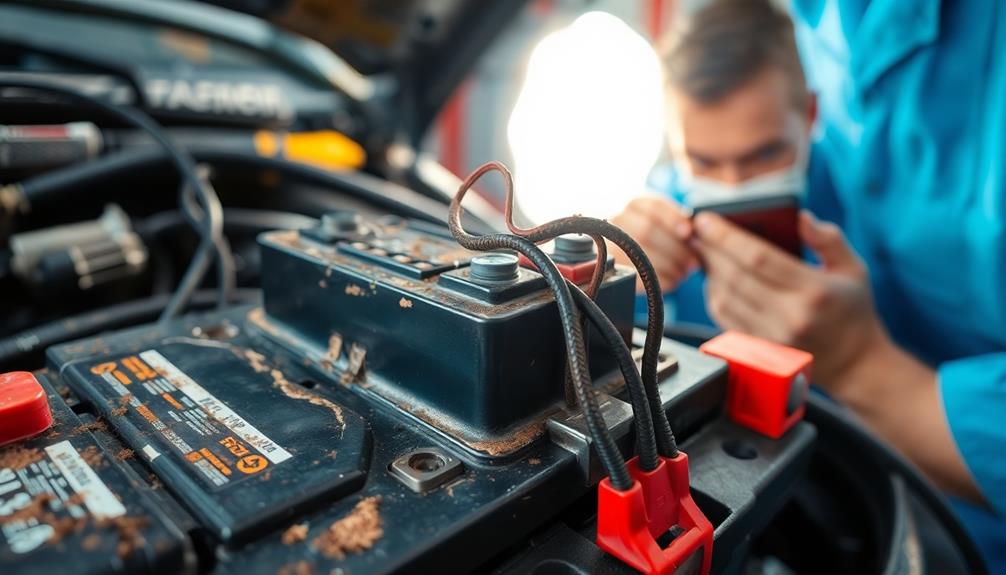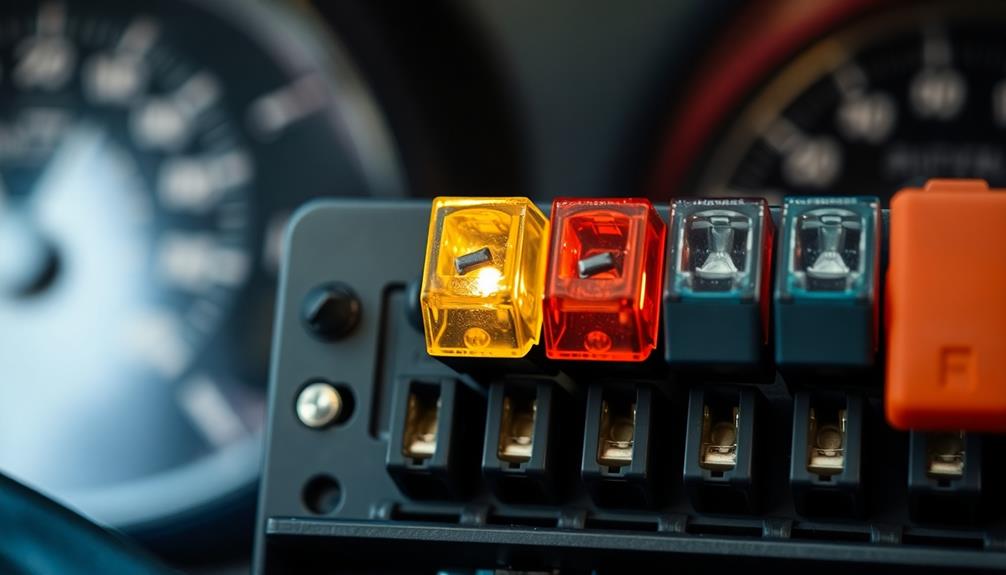Mechanics often don't want you to know that simple environmental factors can save your battery. For starters, cooler temperatures keep batteries healthy, while heat accelerates wear. High humidity? It can corrode terminals and cut performance. Regular maintenance is essential, too—like biannual testing and keeping water levels up. You should also limit accessory use when your engine's off to avoid draining your battery unexpectedly. By staying aware of these factors and making a few adjustments, you can greatly extend your battery's lifespan. There's more to uncover, so let's explore how to maximize your battery's efficiency further.
Key Takeaways
- Regularly cleaning battery terminals prevents corrosion, ensuring optimal electrical contact and enhancing battery performance.
- Testing your battery biannually can catch issues early, extending its lifespan significantly.
- Maintaining proper water levels in batteries with distilled water prevents damage and improves efficiency.
- Limiting accessory usage when the engine is off reduces parasitic drains, preserving battery charge.
- Inspecting the alternator regularly ensures it functions properly, preventing unnecessary battery discharge.
Understanding Battery Lifespan

Understanding the lifespan of your car battery is vital for guaranteeing reliable performance. On average, you can expect your battery to last between 2 to 5 years. However, under ideal conditions, it might stretch to around 6 years.
If you live in a northern climate, you're in luck—cooler temperatures can actually help extend your battery's life by slowing down degradation.
But if you're in a warm climate, you'll want to take care. High temperatures can accelerate sulfation and water loss, leading to a shorter lifespan.
Hybrid and electric vehicle batteries are a different story; they typically last up to 8 years before needing replacement.
Next time you check your battery, consider its age and the environmental factors affecting it. Regular maintenance is necessary in keeping your battery healthy.
A little attention can go a long way in extending its lifespan. So, give us the chance to keep your battery running well, and you won't have to worry about unexpected failures.
Key Factors Influencing Performance

Several key factors influence your car battery's performance, and being aware of them can make an important difference.
First, consider your environment. In northern climates, batteries tend to last longer due to cooler temperatures, which slow down the chemical reactions that cause degradation. In contrast, warm climates increase the risk of sulfation and water loss, greatly reducing your battery's lifespan and overall performance.
Make sure you maintain proper water levels in maintenance-free batteries, as low levels can lead to battery failure. Regularly checking these levels is essential for keeping your battery functioning effectively.
Additionally, you should test your battery every spring and fall. This simple step can help you identify potential issues early on, ensuring effective performance and longevity.
Common Causes of Failure

Many car batteries fail due to common issues that can often be prevented with proper care. One major culprit is bad cell development within the battery itself. When cells degrade, they can't hold a charge, leading to premature failure.
Additionally, low water levels in maintenance-free batteries can cause considerable problems. These batteries rely on proper electrolyte levels for functionality, so neglecting this can result in a dead battery.
Moreover, a faulty alternator can hinder your battery's ability to recharge, leaving you stranded even after short usage. It's important to keep an eye on this component, as it plays a vital role in battery health.
Corroded battery cables can also impede effective charging. If corrosion builds up, your battery won't receive the necessary power from the alternator, leading to failure.
Lastly, a loose alternator belt can affect how well the alternator operates. If the belt isn't tight enough, the alternator won't recharge the battery adequately, ultimately resulting in failure.
Essential Maintenance Practices

Keeping your car battery in top shape requires consistent maintenance practices that anyone can adopt. Start by testing your battery every spring and fall. This helps you catch potential issues early and prevents unexpected failures.
Additionally, just as with wood stoves, guaranteeing compliance with safety standards can enhance your overall maintenance routine and avoid future problems safety standards.
Next, check the water levels if you have a maintenance-free battery; confirming adequate electrolyte levels can greatly enhance performance. Alongside this, inspect your alternator during routine maintenance. A faulty alternator can hinder the battery's ability to charge effectively.
Cleaning corrosion from battery terminals is another essential step. Regularly removing corrosion guarantees a good electrical connection, which boosts charging efficiency and overall battery health.
Identifying Warning Signs

Recognizing warning signs of battery trouble can save you from unexpected breakdowns and costly repairs. Pay attention to these indicators that something might be off with your battery or alternator:
| Warning Sign | What It Means |
|---|---|
| Battery won't hold a charge | Internal issues like bad cells; replacement needed |
| Dimming headlights while running | Potential alternator problems hindering charging |
| Engine dies quickly after jump-start | Alternator failure, vital for battery maintenance |
| Corrosion on battery terminals | Limits charging efficiency; needs regular cleaning |
| Electrical component issues | Indicates underlying battery or alternator problems |
If you notice any of these signs, it's important to act quickly. Ignoring them could lead to larger issues down the road. Regular checks can help you maintain a healthy battery and keep your vehicle running smoothly. Don't let these warning signs slip by; staying proactive can save you time and money in the long run. Remember, your battery is the heart of your vehicle's electrical system, and keeping it in top shape is essential for reliable performance.
Importance of Regular Testing

Identifying warning signs of battery trouble is just the first step toward maintaining your vehicle's reliability. Regularly testing your car battery every spring and fall can help you spot potential issues before they escalate into major problems.
A well-maintained battery can last up to six years in ideal conditions, but without routine checks, you might overlook signs of degradation. Testing your battery's charge and overall health can uncover hidden issues, like bad cell development or low water levels, that could hurt its performance.
Furthermore, it's not just the battery you're checking; you're also evaluating the health of the alternator. If the alternator's malfunctioning, it can prevent the battery from charging properly, leading to premature failure.
Impact of Environment on Batteries

Environmental factors play an essential role in determining your car battery's lifespan and performance. If you live in a northern climate, you'll benefit from cooler temperatures that slow down chemical reactions in the battery, helping it last longer.
However, warmer climates can be harsh on your battery, as high temperatures accelerate sulfation and water loss, greatly reducing its lifespan.
Humidity is another important factor; high moisture levels can lead to corrosion of terminals and connections, which affects your battery's overall efficiency.
You mightn't realize it, but regular maintenance and awareness of your environment can enhance battery longevity. Simple actions like ensuring temperature regulation and keeping connections clean can make a significant difference.
Additionally, be mindful of parasitic drains. Accessories that remain on when the engine's off can cause unexpected battery failures, especially in extreme conditions.
So, whether you're in a chilly region or a hot, humid area, understanding how your environment impacts your battery can help you take better care of it and avoid premature issues.
Stay vigilant, and you'll maximize your battery's potential!
Tips for Maximizing Longevity

To get the most out of your car battery, implementing practical maintenance tips can make a big difference in its longevity. Here are some essential strategies to keep your battery healthy:
| Tip | Description |
|---|---|
| Test Regularly | Check your battery every spring and fall to catch issues early. |
| Clean Terminals | Remove corrosion from battery terminals for better contact. |
| Monitor Water Levels | Verify maintenance-free batteries have proper water levels to avoid damage. |
| Inspect Alternator | Verify your alternator's function to confirm it's charging effectively. |
| Avoid Parasitic Drains | Turn off accessories when the engine's off to reduce wear. |
Frequently Asked Questions
Why Does My Car Keep Saying Battery Saver Active?
Your car says "Battery Saver Active" because it detects low battery charge. It's reducing power to non-essential systems to protect the battery. Check the alternator and battery health to avoid further issues.
What Is the Secret Code to Check Battery?
"A stitch in time saves nine." To check your battery's health, look for the date code on its label. You can also use a multimeter to measure voltage or a battery tester for a thorough evaluation.
How Do You Start a Dead Battery Trick?
To start a dead battery, connect the positive terminal of the dead battery to a charged one, then ground the negative. Start the working vehicle first, rev it slightly, then try starting the dead battery.
Can a Mechanic Check Battery Life?
Did you know that a car battery typically lasts 2-5 years? Yes, a mechanic can check your battery's life by testing its voltage and evaluating its charge capacity, helping you avoid unexpected failures.
Conclusion
By taking a few simple steps, you can extend your battery's life, much like caring for a garden. Just as a plant thrives with proper sunlight and water, your battery flourishes with regular maintenance and attention. Remember, neglecting these practices can lead to premature failure, like a wilting flower. So, invest a little time in understanding your battery—it'll pay off in the long run, keeping your devices powered and performing at their best.









